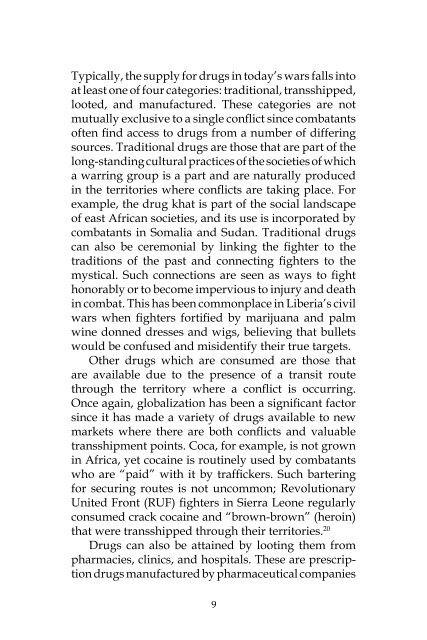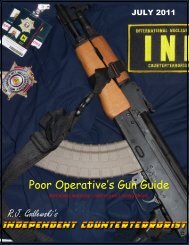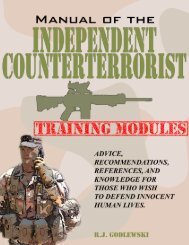R.J. Godlewski's The Independent Counterterrorist. I, Militia. June ...
R.J. Godlewski's The Independent Counterterrorist. I, Militia. June ...
R.J. Godlewski's The Independent Counterterrorist. I, Militia. June ...
- No tags were found...
You also want an ePaper? Increase the reach of your titles
YUMPU automatically turns print PDFs into web optimized ePapers that Google loves.
Typically, the supply for drugs in today’s wars falls into<br />
at least one of four categories: traditional, transshipped,<br />
looted, and manufactured. <strong>The</strong>se categories are not<br />
mutually exclusive to a single conflict since combatants<br />
often find access to drugs from a number of differing<br />
sources. Traditional drugs are those that are part of the<br />
long-standing cultural practices of the societies of which<br />
a warring group is a part and are naturally produced<br />
in the territories where conflicts are taking place. For<br />
example, the drug khat is part of the social landscape<br />
of east African societies, and its use is incorporated by<br />
combatants in Somalia and Sudan. Traditional drugs<br />
can also be ceremonial by linking the fighter to the<br />
traditions of the past and connecting fighters to the<br />
mystical. Such connections are seen as ways to fight<br />
honorably or to become impervious to injury and death<br />
in combat. This has been commonplace in Liberia’s civil<br />
wars when fighters fortified by marijuana and palm<br />
wine donned dresses and wigs, believing that bullets<br />
would be confused and misidentify their true targets.<br />
Other drugs which are consumed are those that<br />
are available due to the presence of a transit route<br />
through the territory where a conflict is occurring.<br />
Once again, globalization has been a significant factor<br />
since it has made a variety of drugs available to new<br />
markets where there are both conflicts and valuable<br />
transshipment points. Coca, for example, is not grown<br />
in Africa, yet cocaine is routinely used by combatants<br />
who are “paid” with it by traffickers. Such bartering<br />
for securing routes is not uncommon; Revolutionary<br />
United Front (RUF) fighters in Sierra Leone regularly<br />
consumed crack cocaine and “brown-brown” (heroin)<br />
that were transshipped through their territories. 20<br />
Drugs can also be attained by looting them from<br />
pharmacies, clinics, and hospitals. <strong>The</strong>se are prescription<br />
drugs manufactured by pharmaceutical companies<br />
9







